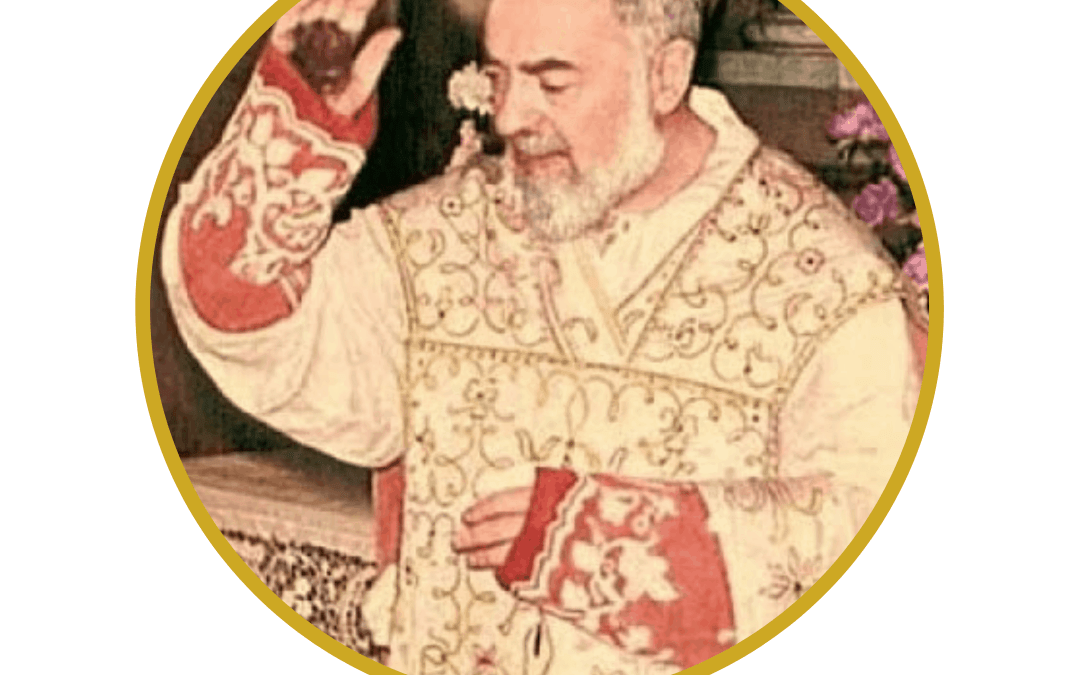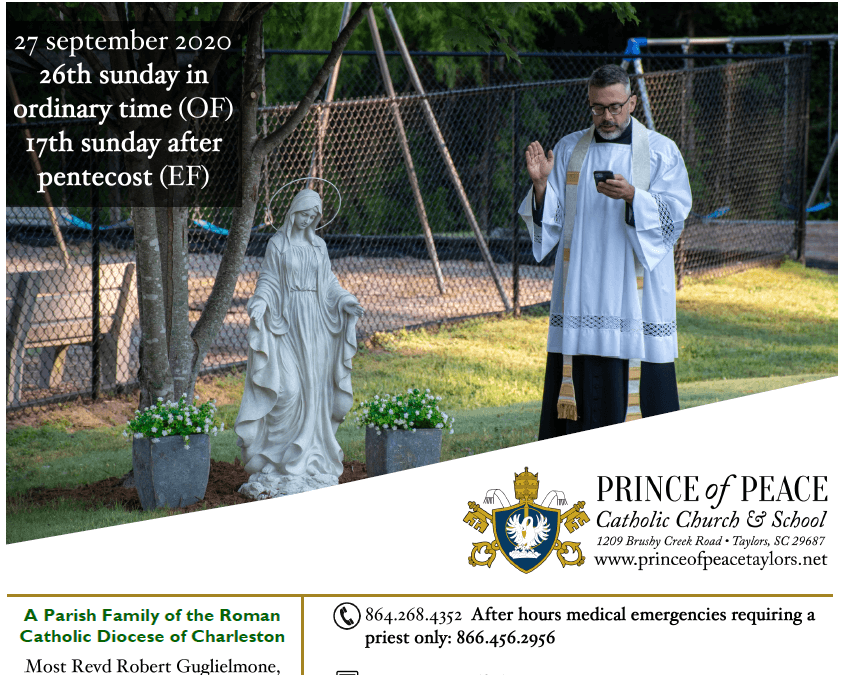
by popadmin | Sep 25, 2020 | Parish Life
Youth basketball sign-ups are now open for all boys and girls in grades K-12 (see
flyer). Practices will be held every Sunday in the PAC, starting 4 October. Guidelines for safety and COVID-19 protocols will be practiced.
We also need additional volunteers to help coach. Please contact Mark Burress (mark.burress@gmail.com) or Maria Rauch (maria.rauch@princeofpeacetaylors.org) if you are interested.
Practices are on Sundays and are as follows:
- Co-Ed iMites (K-1): 1-2p
- Co-Ed Mites/all girls possibility (2-3): 2-3p
- Girls 4th-6th Grade: 3-4p
- Boys 4th-5th Grade: 4-5p
- Boys 6th-8th Grade: 5-6p
- Boys High School: 6-7p
- Men 8-10p

by popadmin | Sep 23, 2020 | CIC Saint Writeups
This feast, also known as “Michaelmas,” was a Holy Day of Obligation until the 18th century. The Catechism of the Catholic Church teaches that “The existence of the spiritual, non-corporeal beings that Sacred Scripture usually calls “angels” is a truth of faith. The witness of Scripture is as clear as the unanimity of Tradition.” Archangels are one of the nine choirs of angels listed in the Bible. (In ascending order, the choirs or classes are: Angels, Archangels, Principalities, Powers, Virtues, Dominations, Thrones, Cherubim, and Seraphim.) St. Michael’s name means “Who is like unto God?” and he is known as “the prince of the heavenly host.” St. Michael’s task is doing battle against Satan and all his evil followers. His name appears in Scripture four times. He is usually depicted as a mighty warrior and is known as a champion of justice; the guardian of the Church; the protector and defender of all the friends of God. We invoke St. Michael for help in the fight against evil and to rescue souls from Satan, especially at the hour of death. St. Gabriel’s name means “God is my strength” and appears as a messenger in the Bible three times (to the prophet Daniel; to Zachariah to announce the birth of John the Baptist; and to Mary at the Annunciation). St. Gabriel’s famous greeting to Our Lady at the Annunciation was: Hail Mary, full of grace. St. Raphael’s name means “God has healed.” Knowledge of St. Raphael comes from the book of Tobit. His mission as healer and fellow traveler with Tobias has caused him to be invoked for journeys and at critical moments in life. Tradition also holds that Raphael is the angel that stirred the waters at the healing pool in Bethesda.
Another angelic feast is celebrated this week on 2 October: Feast of the Guardian Angels. “From infancy to death human life is surrounded by their watchful care and protection. Beside each believer stands an angel as protector and shepherd leading him to life.” (Catechism of the Catholic Church, 336) St. Bernard wrote “…the angels are here; they are at your side, they are with you, present on your behalf. They are here to protect you and to serve you.” God has given each of us the incredible gift of a guardian angel – they will protect and help us attain eternal salvation. Deo Gratias!
“For he will give his angels charge of you to guard you in all your ways.” (Psalm 91:11)
Ideas for celebrating this feast day at home:
· Memorize the Prayer to St. Michael the Archangel. Pray it daily for protection from evil!
· In honor of St. Gabriel, Learn the Angelus. Traditionally, it is prayed at 6 and 12 o’clock
· Make recipes related to Michaelmas. St. Michael Bannock bread is traditionally served with roasted goose and carrots. Roasted chicken or Cornish hens work, too! An easy option is picking up a hot rotisserie chicken from the store. Other food ideas: make an angel food cake, devil’s food cake, angel hair pasta, or deviled eggs. For extra fun, poke cocktail swords (or little toy swords from play action figures) into your food! Decorate with white as symbolic of the angels.
· Do you have any angel-shaped Christmas cookie cutters? Use them to trace and color angels to decorate the house! OR, bake up some sugar cookies in angelic shapes this week.
· Folklore says that Michaelmas day is the last day that blackberries can be picked and eaten because when St. Michael expelled the devil from heaven, he fell from the skies and landed in a prickly blackberry bush. Satan cursed the fruit, stamped and spat on it, making them unfit for eating. So, on this feast day: enjoy blackberry wine or buy fresh blackberries to put on oatmeal, bake into a pie or cobbler, or top an angel food cake with them.
· Saint Michael is the patron saint of police officers. This is the perfect day to stop by your local police station with thanks and treats. Tell them that it’s their feast day so you brought some food for feasting and you are praying for them in a special way on Michaelmas.
· Don’t forget to memorize the Prayer to your Guardian Angel on October 2!

by popadmin | Sep 20, 2020 | CIC Saint Writeups
23 September: Feast of Saint Padre Pio. This feast is in honor of Italian Franciscan priest St. Pio of Petrelcina, better known as “Padre Pio” and renowned for his suffering, humility and miracles. Padre Pio was born Francesco Forgione in 1887 as one of seven children. His growing up years were marked by daily Mass, family rosary, and acts of penance. He decided at a young age to dedicate his life to God. In 1903, he put on the Franciscan habit as a Capuchin Friar. Capuchin priests seek extreme poverty, strictness, and simplicity. He took the name Pio, a modern Italian form of “Pius,” in honor of Pope St. Pius V. He was ordained a priest in 1910. Padre Pio suffered through health problems and serious illness. He experienced religious ecstasy and attacks from the devil (friars would report strange noises from his cell). In 1918, Padre Pio first received the painful Stigmata – the five wounds of Christ’s passion. This made him the first stigmatized priest in Church history. During World War I, Padre Pio served in the military and offered his own personal suffering for an end to war. Once again, he received the Stigmata wounds. They would remain with him for 50 years. Countless doctors looked at his wounds with no explanation. His wounds bled painfully every day with no drop in blood pressure. Against his wishes, Padre Pio’s reputation for holiness and miracles began to attract crowds. Countless people flocked to his confessional and many more received his saintly counsel and spiritual guidance through correspondence. His life was marked by long hours of fervent prayer and patient suffering. Padre Pio died in 1968, and was declared a saint in 2002.
Ideas for celebrating this feast day at home:
- Watch this reflection with Deacon Gus
- Today’s menu should include Italian foods in honor of this Italian born saint (cappuccino, pasta, risotto, pizza, etc). For today’s feast day treat, make easy “Stigmata rice krispy treats”: use a hand shaped cookie cutter (or your own hand as a guide!) to cut out rice krispy treats. Use a dab of red icing in the center of the hand treats to look like a Stigmata.
- St. Padre Pio loved to hear confessions: his feast day is a great reminder for us! Put it on your calendar and make a commitment to go to confession soon.
- Watch a free video on FORMED about Padre Pio
- Family prayer time: St. Padre Pio said that “Prayer is the oxygen of the soul.” Before bedtime, kneel together as a family and take turns praying. Try to make this a part of your daily routine. Padre Pio’s own family was known for praying a family rosary – try to add this to your family life, too! Pray virtual rosaries with your parish family (click here for the link to pray at 7pm on Su, Mo, Tu, Thu, Fr). This is a beautiful way for your children to see prayer modeled by their parents and fellow parishioners.




Recent Comments